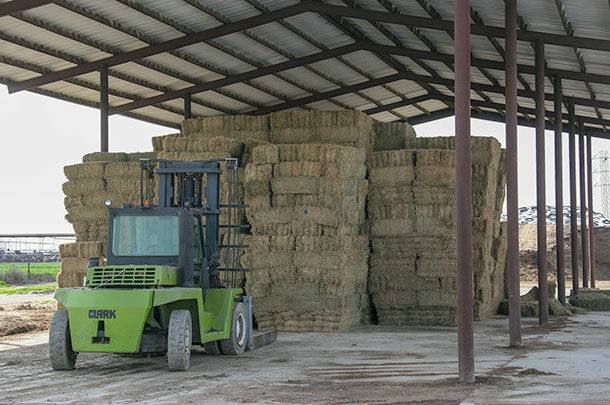If you want that beautiful green color and fresh hay smell that’s so important, I recommend using a crop preservative so you can bale higher-moisture hay.
Here’s why: More than 70 percent of the nutritional value of alfalfa is in the leaves, so you want to capture every leaf possible. When you bale drier hay, you lose some of those valuable leaves through leaf shatter. Higher-moisture hay retains more leaves, and that results in better nutritional quality and more harvested tons per acre. For untreated hay, the high end of moisture for small square bales is 15 percent. With a crop preservative, you can bale at up to 30 percent moisture.
Forage never has more quality than right after you first cut it. Once cut it only goes one direction – down – so to preserve maximum nutritional value after that, you want to get the alfalfa off the field as soon as you can. When you use a crop preservative, you are less at the mercy of the weather. You can start baling earlier, finish baling later and get that hay into the stack or shed at maximum protein content.
I recommend using an automatic applicator system to provide accurate application of the crop preservative; the auto system pays back faster. How? It minimizes the unhappy customer risk associated with moldy bales and prevents overapplying product when a lesser amount per ton will do. It’s well worth the expense for top-quality bales that garner a top-quality price.
Producing uniform square-shouldered bales is a must if you’re using an accumulator or bale wagon.
The following factors impact overall bale shape, density and length, all related primarily to how crop is fed into the baler and moved into the bale chamber:
Pickup adjustment
- Set the pickup flotation to keep the load on the pickup wheel to a minimum while not allowing the pickup to bounce and leave crop in the field, especially when baling in rough fields.
- Adjust the pickup wheel to maintain pickup tines 1 to 2 1/2 inches above the ground. In rocky or uneven field conditions, set the pickup tines higher to provide more clearance.
- The pickup wind guard should be adjusted to hold the material in contact with the tines to promote positive feeding.
- Adjust the lower stop so fingers are held no higher than 1 inch above the pickup tines. Higher-volume windrows may require additional clearance; lighter crops require less clearance and greater contact with the wind guard.
- Check your windrow pickup on a regular basis for bent or broken tines and replace them as needed.
Drive belt
The pickup drive belt acts as a “slip clutch” for the pickup. Make sure the belt slips as designed. If it doesn’t, because of excess tension or rust in the V-pulley, pickup damage can result.
Windrow size and ground speed
The windrow size, ground speed and crop yield translate into the feed rate, or the volume of material fed into the baler. The most desirable bale characteristics for uniform shape and size are achieved when the feed rate is producing 2- to 3-inch-thick bale slices.
Keep the windrow to the right-hand side of the pickup. To make sure the crop feeds evenly in the bale, make the windrow as wide as the baler pickup. Vary ground speed according to windrow volume to produce the desired slice thickness. Count the plunger strokes between needle cycles, and then divide by the set bale length to determine flake thickness, and maintain PTO speed at 540 rpm to produce thinner slices.
Bale density
Dense, square-shouldered bales hold their shape and provide more stable stacks. Ground speed and feed rate affect density. Lower feed rates provide thinner flakes, which translate into more dense bales.
The density of the bale, and consequently bale weight, is normally adjusted by varying the force placed on the tension rails on the top and bottom of the bale chamber. Higher force increases the effort required to push the bale through the chamber, which increases bale density.
On spring tension systems, tension adjustment cranks alter the force that the springs apply to the rails. Turning the cranks clockwise increases spring force, bale weight and density.
Doors on the sides of the bale chamber can be pressed into the sides of the bale to increase resistance and therefore density. Use care to adjust doors evenly from side to side.
Hay wedges can be used in the interior of the bale chamber. Add wedges only if the tension rail and bale chamber door adjustments do not produce enough density. Up to three pairs of wedges can be added. The front wedges are standard equipment. They help hold bale slices in place and should never be removed, as tying difficulties may result.
Bale length adjustment
Consistent bale length is especially important when using a bale wagon or accumulator to pick up bales. Bale length is controlled by the metering wheel that is rotated by the bale passing through the bale chamber. The metering wheel raises the knotter trip arm, which releases the knotter clutch pawl. The length of trip arm travel (how far down it can drop before re-engaging the metering wheel) determines bale length.
The bale counter chain and spring may require adjustment when changing bale length. Bale slice thickness has an important effect on bale length. If knotters trip during what would normally be the last slice of the bale, the resulting bale is the desired length. If knotters do not trip on the last slice, an additional slice will be added. This results in one bale being as much as 3 1/2 inches longer than desired, while one additional slice on the other bale results in a variation of up to 7 1/2 inches in bale length.
Feed is the biggest expense in raising livestock, so whether you’re baling hay for your own horses or cattle, or you’re selling it, you want to do it right. Follow these tips to produce hay with good nutritive value and a minimum loss of dry matter. By the end of summer, you’ll have a shed full of quality small square bales. ![]()
PHOTO: Factors impacting overall bale shape, density and length can be controlled to produce quality small square bales. Photo by Darren Olsen.

-
Curt Hoffman
- Brand Marketing Manager, Crop Packaging
- New Holland











